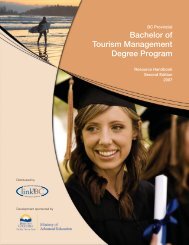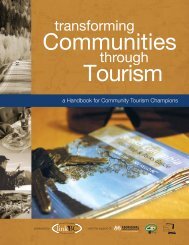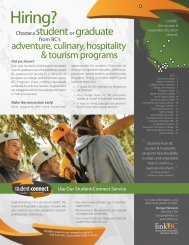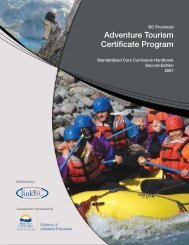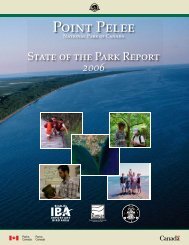Cultural Heritage Tourism Handbook - LinkBC
Cultural Heritage Tourism Handbook - LinkBC
Cultural Heritage Tourism Handbook - LinkBC
- No tags were found...
You also want an ePaper? Increase the reach of your titles
YUMPU automatically turns print PDFs into web optimized ePapers that Google loves.
7.2 Make Effective and Attractive Signage a High Priority8. Prepare Your ActivitiesSignage is an essential part of the product development and marketing process, often overlookedby communities in this technological era. Visitors may have GPS, excellent maps, and more thanone set of good eyes, but can still get easily lost and confused in communities with outdated orinadequate signage.This chapter addresses ways you can engagevisitors with a variety of activities before theyleave with positive memories.An effective signage program can attract visitors while providingclear directions and information. It can also play a critical role inconnecting people to the culture and heritage of the region. Signscompatible with local character that conform to national or internationalstandards will be better understood by visitors from differentcountries and cultures. Types of tourism and services signs include 42 :1. Welcome and entrance signs. Keep your message strongand uncluttered but highlight your cultural/heritage character,theme(s) and brand.2. Way-finding, directional and information signs.Ensure these are prominent, large enough and in all the rightspots. Make sure there is adequate parking to entice visitorsto stop.3. <strong>Tourism</strong> attractions signs. Ensure these are on all mainroutes, and there are sufficient numbers. Position these separatelyfrom your welcome signs.4. Business service signs clearly showing products andservices.5. “Blade signs” placed perpendicular to the street, are morelikely to be noticed by visitors driving or walking by.6. Interpretive signs. Create a set of interpretive signs to tellyour community’s story, and invest in professional design andsign creation services.With your people prepared, and your community’s sense of placeclearly articulated, you’re ready to focus on the activities you hopeto share with your guests.“Experiential tourism is learningsomething by doing somethingwith someone who lives here”8.1 Create “Lots to Do”– Bill Kendrick, Experience PEIWith culture buffs, travel is more than where you’ve been. It’s aboutwhat you did, how it made you feel, the people you met, and thememories you took home. Once your community has developedyour inventory, assessed your people, and revamped your overalldestination, you can identify and develop new visitor experiences.This checklist may assist with the process:Developing <strong>Cultural</strong>/<strong>Heritage</strong> <strong>Tourism</strong> Experiences: A Checklist£ £ Identify market prospects by creating a profile ofcurrent and potential cultural/heritage tourism markets.£ £ Look at what is currently being offered from thevisitor’s perspective—what do they stand to gainfrom participating in local events and activities?£ £ Reflect on your competitive advantage. What does yourcommunity do better than any other? It may be a betterlocation, an exclusive line of merchandise at one of yourattractions, better prices, exceptionally high quality customerservice, or the value-added services or experiences provided.£ £ Think of the features that make your cultural/heritagetourism destination unique. Unique selling propositions(USPs) are a feature or combination of features that makeyour product attractive to a market segment, presentedto the visitor as a special reason to visit your community.£ £ Identify experiences offered in neighbouring communities.Are there any experiences you could packagetogether to increase traffic for both destinations?£ £ Consider what you already do well. What attractions andexperiences are already winners? How might enhancing thesewith a cultural/heritage component work to your advantage?£ £ Look at the timing of your tourism offerings. Would it workto lengthen your tourism season?This next case study tells the story of how a community took a smallevent held in the tourism shoulder-season and transformed it intoa well-known festival, capitalizing on local strengths.50 51



